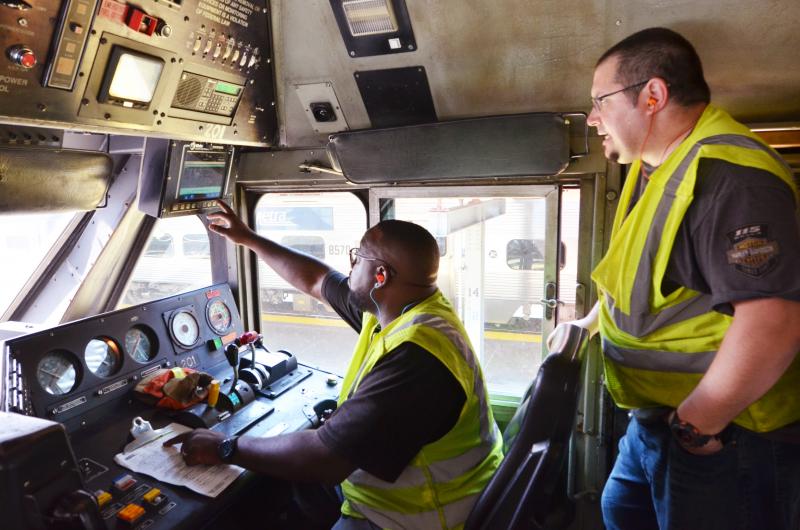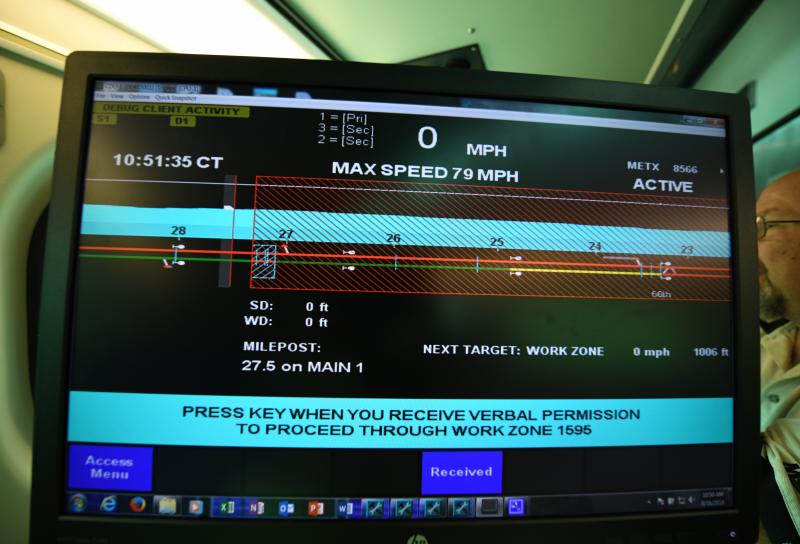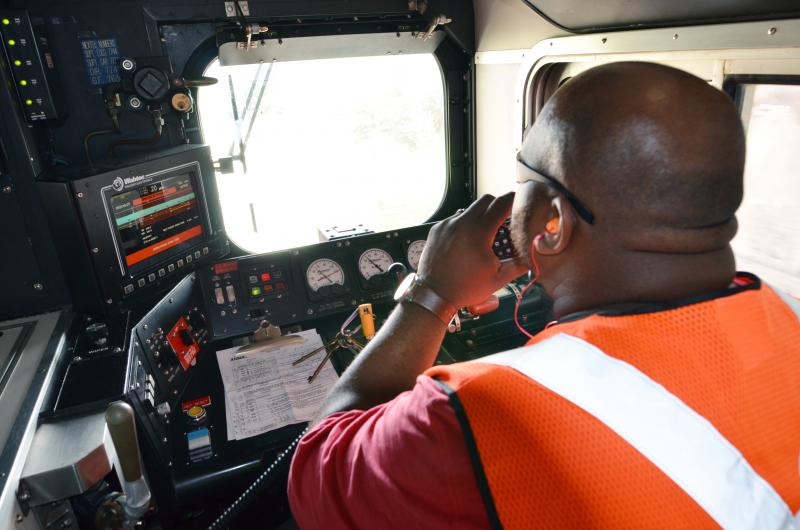
Engineer Jason Cook, seated, checks operating bulletins during PTC initialization under the guidance of Senior PTC Test Engineer Tom Alonzo before a PTC test run on the Rock Island Line.
It’s after 9 a.m. on a mid-August weekday and a train comprised of one locomotive and two railcars leaves the yard at Blue Island heading south on the Rock Island Line to Joliet. It’s the Metra Positive Train Control (PTC) test train, and its crew has been working the line for weeks testing PTC in an actual operating environment.
Up until now, most of Metra’s PTC testing has been in the lab, creating virtual scenarios and verifying the system’s performance. Now, the test train is confirming that the PTC software and hardware in the train and along the Rock Island Line works as intended.
Metra and railroads across the U.S. are hard at work to implement PTC by the federal government’s Dec. 31 deadline. Metra plans to have six of its 11 lines operating with PTC by year’s end and to meet other milestones outlined by the federal government to qualify for a two-year extension for the complete implementation of PTC across its entire railroad by the end of 2020.
"Implementing PTC in Chicago's dense and busy railroad network has been very challenging, but Metra is right where we said we'd be in terms of finishing the job," said Metra CEO/Executive Director Jim Derwinski. "Working with our freight partners, we expect to have PTC implemented or in revenue service demonstration on the Rock Island Line, the SouthWest Service, the BNSF and the three lines operated by Union Pacific by the end of 2018."
Meanwhile out on the railroad, Senior PTC Test Train Engineer Tom Alonzo and PTC Manager Bob Conway are spending another day putting PTC through its paces on a series of runs between Joliet and Chicago’s LaSalle Street Station. Alonzo operates the train while Conway reviews a continuous flow of data generated by PTC.

PTC terminal display shows braking zone and request for engineer to acknowledge that train has permission to proceed through work zone.
Today, two Rock Island engineers Nate Russell and Jason Cook have come on board for the opportunity for a little hands-on experience. This is in addition to the formal PTC training that all engineers are required to complete. Both Russell and Cook will have the chance to operate the train during test runs under the guidance of Alonzo while Conway monitors the PTC system’s performance.
First, they learn to initialize the PTC system, a process that must be performed before each train run. The initialization process requires that the engineer input information about the specific train run, including the locomotive and cab car numbers and the number of cars in the train and whether the locomotive is pulling or pushing the train. If the information doesn’t match what Metra’s dispatching department has input for that run, PTC will not initialize and the train cannot depart.
Why is this information so important? The type of locomotive and the number of cars used for each train determines the train’s total weight, and accurate weight information is essential in calculating the correct braking algorithm. PTC’s purpose is to slow or stop a train if it’s over the track speed limit or if an engineer disregards a speed restriction, a signal or an upcoming work zone.
The initialization process also requires that the engineer review every track bulletin in effect on the line during the train run. Track bulletins detail the location of all activity on the railroad on a given day, and whether the engineer needs to reduce speed, or obtain permission from the work crew before entering a work zone. The engineer compares the bulletins displayed on the PTC terminal with the information contained in a printed daily operating bulletin before pressing a button to confirm them.
As the train moves out onto the main line, the display on the PTC terminal changes to show the track features 5 miles in front of the train and 1 mile behind it.
When the train approaches a reduced speed zone, the display begins to change again, showing a target area where the engineer needs to begin reducing speed. If the engineer fails to do so, PTC will provide an audible warning. If the train does not begin to slow within 30 seconds, PTC will stop the train.
After beginning his run with the PTC system, one engineer expresses concern that his focus needs to be on the track in front of him and not on a computer screen. Alonzo assures him that the only time he will need to pay attention to the PTC screen while moving down the track is if an alert sounds, because that means that PTC is about to stop the train if he doesn’t acknowledge the alert and comply with its instructions.
The test run did more than familiarize the engineers with PTC. They were provided with a real-life demonstration of how PTC will protect workers on the tracks.
In this case, the engineer verbally received permission by radio from the employee in charge of the work crew to enter the work zone. However, to demonstrate PTC’s effectiveness, Alonzo instructed the engineer not to acknowledge the work zone through PTC.
The verbal authorization ensured that workers were clear of the tracks and safe. But because the engineer did not acknowledge the work zone through the PTC terminal, PTC began to slow the train within 30 seconds of sounding an alert, bringing it to a stop 1,000 feet short of the work area.
“It did exactly what it was supposed to do,” Alonzo said. “It prevented an unauthorized train from entering the work zone.”

Metra Engineer Nate Russell radios the employee in charge of a work zone along the tracks. Note the red bar displayed on the PTC terminal at left showing that PTC is stopping the train .

PTC Manager Bob Conway watches the data scroll by as the PTC test train runs.
After the testing ends on the Rock Island Line and engineers complete training, trains in passenger service will begin using PTC, with the goal of all trains on the Rock Island running PTC by the end of September. The test train will then move on to the SouthWest Service. Metra plans to to fully implement PTC on that line by year’s end.
PTC implementation is also underway on the lines controlled by Metra’s freight partners. The BNSF Line to Aurora launched full PTC service in June. The three lines operated by the Union Pacific plan to have PTC in service by year’s end. On the Metra Electric and the Milwaukee District West lines, PTC will go online in 2019. Metra plans to implement PTC on the Milwaukee District North Line in 2020 and is working with the CN, which owns the tracks used by its Heritage Corridor and North Central Service lines to comply with the final federal deadline of Dec. 31, 2020.
Thus far, Metra has spent more than $216 million to install PTC and expects to spend as much as $400 million to complete the job and $20 million annually to operate it. Altogether, U.S. commuter railroads expect to spend $4.1 billion to implement PTC.
PTC has been an enormous technical and financial challenge for the rail industry, but Metra and its freight partners have been fully engaged in overcoming the challenges unique to Chicago, understanding that PTC will improve safety on the tracks for both our customers and employees.